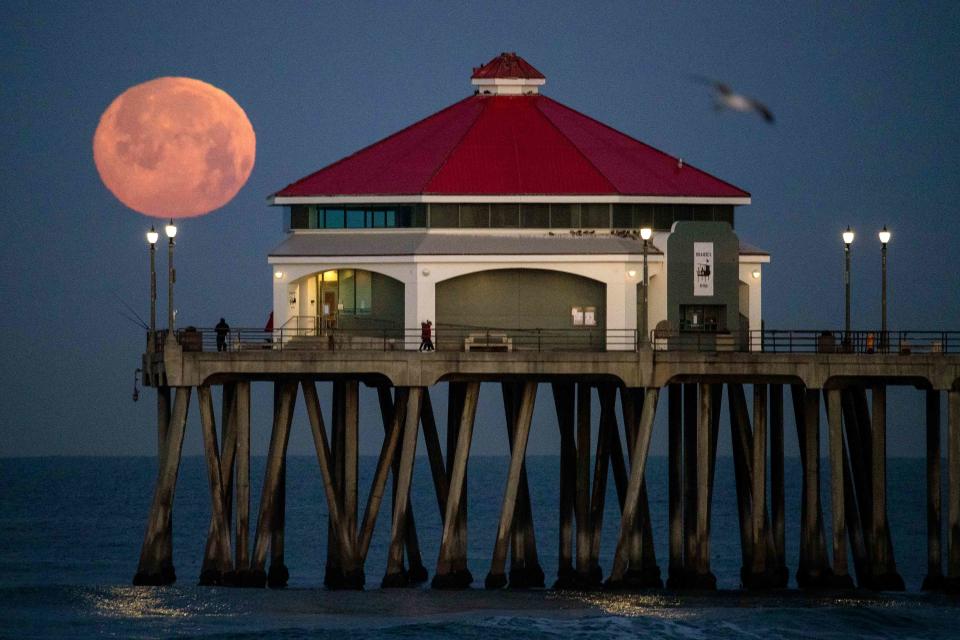You Can See a 'Flower Moon,' Meteor Shower, and Lunar Eclipse in the Skies This May
It's a packed month for the night sky.

Getty Images
If April’s meteor showers and eclipse got you in the mood for stargazing, you’re in luck: May has even more night-sky treats in store.
The month brims with bucket-list nightscapes, from another meteor shower to a rare meeting of Jupiter and the moon — and a solid chance to admire a bright Mercury. As always, it’s important to look for a stargazing perch with limited light pollution, such as these dark-sky parks around the U.S. Even better if you can book a night in the world’s best stargazing hotels.
Ready for another action-packed astro month? Grab your stargazing binoculars — here are the best things to watch for in May’s night sky.
May 5: "Flower moon"
May’s full moon, known as the "flower moon," — which earned its name for the proliferation of blossoms the month brings, according to The Old Farmer’s Almanac, occurs on May 5. Alternative names include planting moon, used by the Dakota and Lakota communities to mark May’s seed-planting season. The Cree people use the term budding or leaf-budding moon as the month sees the resurgence of local plants. May’s new moon hits on the 19th.
May 5: Penumbral lunar eclipse
Between 11:15 a.m. and 3:32 p.m. ET, the moon will travel through Earth’s shadow, sparking a phenomenon known as a penumbral lunar eclipse. This kind of eclipse happens when the Earth moves between the sun and moon, according to In-the-Sky.org. Unlike last month’s eclipse, this type of eclipse is subtle to the eye. This penumbral lunar eclipse will be more noticeable than past eclipses of this nature, as the entirety of the moon’s face will lie within Earth’s shadow, known as the penumbra. The moon’s dimming will be more noticeable, although it’s only visible in places where the moon is above the horizon during this timeframe—so Asia, Russia, Africa, Antarctica, and Oceania.
May 6-7: Eta Aquarids meteor shower
This month continues April’s meteor shower entertainment with Eta Aquarids, known to be above average with the possibility of producing up to 60 meteors per hour at its peak, according to Seasky.org. This month’s shower will be more powerful in the southern hemisphere; those in the northern hemisphere will likely see around 30 meteors per hour at most. It reaches its peak the night of May 6, which isn’t ideal timing given the almost full moon. While you may not see the most vibrant meteor displays, it’s still worth heading out for this powerful show. Look to the constellation Aquarius for shooting stars, although they may appear throughout the sky.
May 17: Lunar occultation of Jupiter
Stargazers in portions of Europe and the Americas can see a rare interstellar event on May 17: the moon passing in front of Jupiter (known as a lunar occultation). Only a sliver of the world will have the perfect ingredients to spot the sight — a location in the path of visibility and skies dark enough to fully take it in. According to In-the-Sky.org, it will begin around 7:30 a.m. ET, when Jupiter disappears behind the moon. The planet will reappear by 8:45 a.m. The next time we’ll see an lunar occultation of Jupiter won’t be until 2026. The best viewing will be in the Midwest and mountain west regions of the U.S., where the skies remain darker. That said, Jupiter is bright enough to see in daylight, especially with binoculars or telescopes—as long as you know where to find it, per Space.com. (As a reminder, never direct your binoculars or telescopes to the sun during daylight hours.)
May 29: Mercury reaches greatest morning elongation
If you missed your chance to see Mercury last month, fear not: May 29 provides another solid chance. The speedy planet will hit its greatest morning elongation at 24.9 degrees from the sun before sunrise this morning. It will also be at its highest point above the horizon. According to Earthsky.org, you’ll need to look in the direction of the sunrise to spot the planet. Uranus and Venus will shine above Mercury this morning, while Jupiter lies between Mercury and the sun. Neptune sits closer to the horizon beneath the sun, too. Use stargazing apps, such as SkySafari or Star Walk, to admire these interstellar views.
For more Travel & Leisure news, make sure to sign up for our newsletter!
Read the original article on Travel & Leisure.


